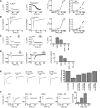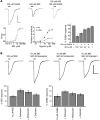Glyoxalase 1 increases anxiety by reducing GABAA receptor agonist methylglyoxal
- PMID: 22585572
- PMCID: PMC3366407
- DOI: 10.1172/JCI61319
Glyoxalase 1 increases anxiety by reducing GABAA receptor agonist methylglyoxal
Abstract
Glyoxalase 1 (Glo1) expression has previously been associated with anxiety in mice; however, its role in anxiety is controversial, and the underlying mechanism is unknown. Here, we demonstrate that GLO1 increases anxiety by reducing levels of methylglyoxal (MG), a GABAA receptor agonist. Mice overexpressing Glo1 on a Tg bacterial artificial chromosome displayed increased anxiety-like behavior and reduced brain MG concentrations. Treatment with low doses of MG reduced anxiety-like behavior, while higher doses caused locomotor depression, ataxia, and hypothermia, which are characteristic effects of GABAA receptor activation. Consistent with these data, we found that physiological concentrations of MG selectively activated GABAA receptors in primary neurons. These data indicate that GLO1 increases anxiety by reducing levels of MG, thereby decreasing GABAA receptor activation. More broadly, our findings potentially link metabolic state, neuronal inhibitory tone, and behavior. Finally, we demonstrated that pharmacological inhibition of GLO1 reduced anxiety, suggesting that GLO1 is a possible target for the treatment of anxiety disorders.
Figures







Similar articles
-
Neuronal overexpression of Glo1 or amygdalar microinjection of methylglyoxal is sufficient to regulate anxiety-like behavior in mice.Behav Brain Res. 2016 Mar 15;301:119-23. doi: 10.1016/j.bbr.2015.12.026. Epub 2015 Dec 19. Behav Brain Res. 2016. PMID: 26711908 Free PMC article.
-
Glyoxalase 1 and its substrate methylglyoxal are novel regulators of seizure susceptibility.Epilepsia. 2013 Apr;54(4):649-57. doi: 10.1111/epi.12121. Epub 2013 Feb 14. Epilepsia. 2013. PMID: 23409935 Free PMC article.
-
Glyoxalase 1 (GLO1) Inhibition or Genetic Overexpression Does Not Alter Ethanol's Locomotor Effects: Implications for GLO1 as a Therapeutic Target in Alcohol Use Disorders.Alcohol Clin Exp Res. 2018 May;42(5):869-878. doi: 10.1111/acer.13623. Epub 2018 Apr 18. Alcohol Clin Exp Res. 2018. PMID: 29532486 Free PMC article.
-
Role of glyoxalase 1 in methylglyoxal detoxification-the broad player of psychiatric disorders.Redox Biol. 2022 Feb;49:102222. doi: 10.1016/j.redox.2021.102222. Epub 2021 Dec 22. Redox Biol. 2022. PMID: 34953453 Free PMC article. Review.
-
Glyoxalase system in yeasts: structure, function, and physiology.Semin Cell Dev Biol. 2011 May;22(3):278-84. doi: 10.1016/j.semcdb.2011.02.002. Epub 2011 Feb 15. Semin Cell Dev Biol. 2011. PMID: 21310260 Review.
Cited by
-
Methylglyoxal, the dark side of glycolysis.Front Neurosci. 2015 Feb 9;9:23. doi: 10.3389/fnins.2015.00023. eCollection 2015. Front Neurosci. 2015. PMID: 25709564 Free PMC article. Review.
-
Lactoylglutathione lyase, a critical enzyme in methylglyoxal detoxification, contributes to survival of Salmonella in the nutrient rich environment.Virulence. 2015;6(1):50-65. doi: 10.4161/21505594.2014.983791. Virulence. 2015. PMID: 25517857 Free PMC article.
-
Neuronal overexpression of Glo1 or amygdalar microinjection of methylglyoxal is sufficient to regulate anxiety-like behavior in mice.Behav Brain Res. 2016 Mar 15;301:119-23. doi: 10.1016/j.bbr.2015.12.026. Epub 2015 Dec 19. Behav Brain Res. 2016. PMID: 26711908 Free PMC article.
-
Methylglyoxal in the Brain: From Glycolytic Metabolite to Signalling Molecule.Molecules. 2022 Nov 15;27(22):7905. doi: 10.3390/molecules27227905. Molecules. 2022. PMID: 36432007 Free PMC article. Review.
-
Emerging Glycation-Based Therapeutics-Glyoxalase 1 Inducers and Glyoxalase 1 Inhibitors.Int J Mol Sci. 2022 Feb 23;23(5):2453. doi: 10.3390/ijms23052453. Int J Mol Sci. 2022. PMID: 35269594 Free PMC article. Review.
References
Publication types
MeSH terms
Substances
Grants and funding
LinkOut - more resources
Full Text Sources
Other Literature Sources
Medical
Molecular Biology Databases
Research Materials
Miscellaneous

